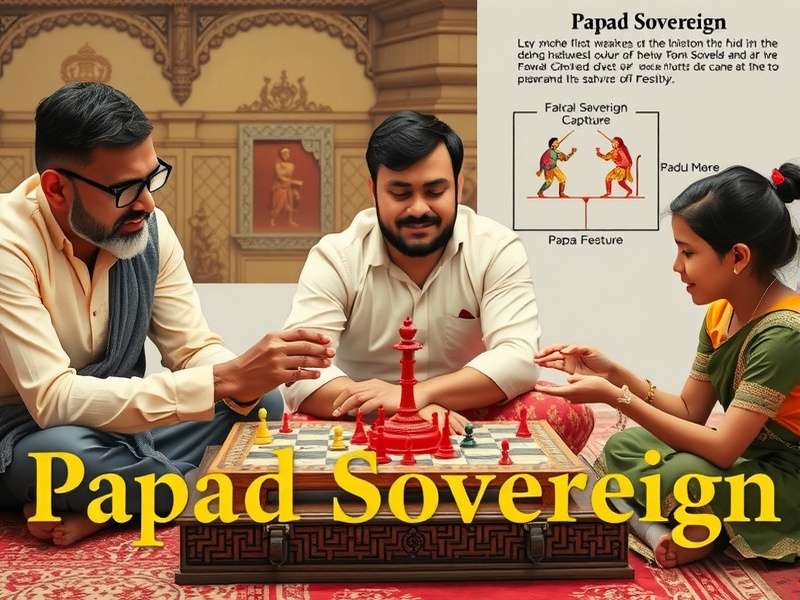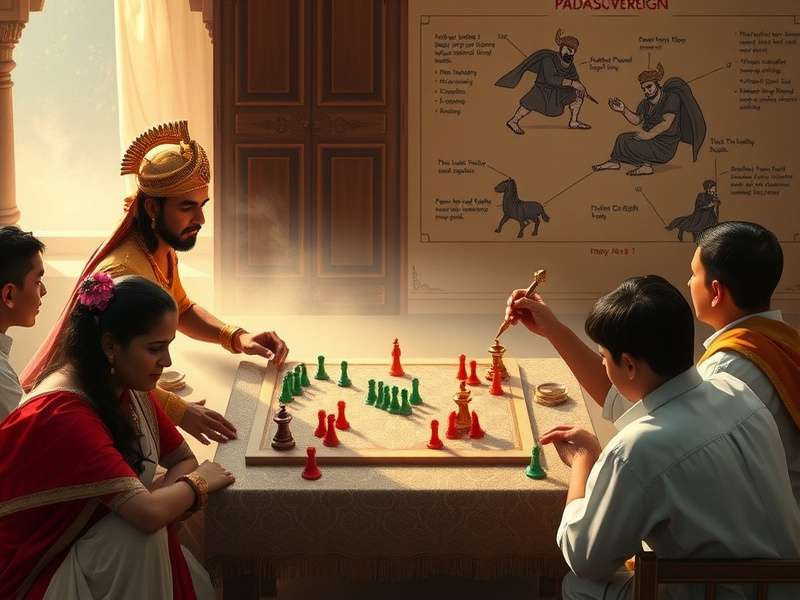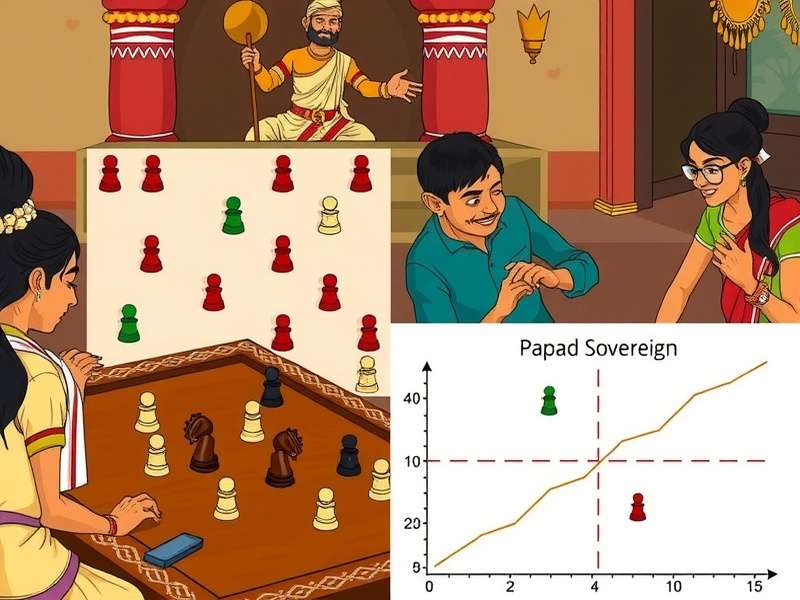Overview of Papad Sovereign
Papad Sovereignis a traditional Indian board game that has been played for generations across the Indian subcontinent. This captivating game combines elements of strategy, luck, and social interaction, making it a favorite during festivals and family gatherings.
🎯 Key Characteristics:The game is known for its unique circular board design, colorful playing pieces, and complex rule system that rewards both tactical thinking and adaptability.
Unlike Western board games,Papad Sovereignincorporates cultural elements and traditional values into its gameplay. The game's mechanics reflect Indian philosophical concepts of karma, destiny, and strategic planning.

Traditional setup of Papad Sovereign showing the circular board and player pieces
The name "Papad Sovereign" itself carries cultural significance, with "Papad" referring to the crisp, round Indian bread that resembles the game board, and "Sovereign" indicating the royal status achieved by winning players.
Historical Origins and Evolution
The origins ofPapad Sovereigncan be traced back to ancient India, with references found in historical texts dating to the Gupta Empire period (approximately 4th to 6th centuries CE). Early versions of the game were played with seeds, stones, and hand-drawn boards on the ground.
Throughout medieval India, the game evolved significantly. Regional variations emerged across different states, each adding unique rules and gameplay elements. The Mughal era saw the game adopted in royal courts, where elaborate versions with precious materials were created for nobility.

British colonial rule nearly led to the disappearance ofPapad Sovereignas Western games gained popularity. However, a cultural revival movement in the early 20th century helped preserve and standardize the game rules, ensuring its survival to modern times.
📜 Historical Significance:Archaeological evidence suggests that early forms of Papad Sovereign were played as far back as 2000 years ago, with game pieces discovered at various historical sites across India.
The post-independence era sawPapad Sovereignembraced as a symbol of Indian cultural heritage. National tournaments began in the 1970s, and today the game enjoys international recognition with players worldwide.
Complete Game Rules and Mechanics
Understanding the rules ofPapad Sovereignis essential for both beginners and experienced players. The game is typically played by 2-4 players and requires a combination of strategic planning and adaptability to changing board conditions.
Basic Setup and Components
- Game Board:Circular board divided into 24 segments representing different territories
- Playing Pieces:Each player has 12 distinctive pieces (traditionally made of wood or clay)
- Dice:Two traditional six-sided dice are used for movement
- Starting Positions:Players begin from designated starting points on the board
Core Gameplay Mechanics
The primary objective inPapad Sovereignis to navigate all your pieces around the board and into the central "royal court" before your opponents. Players take turns rolling dice and moving their pieces according to the numbers rolled.
🎲 Movement Rules:Pieces move clockwise around the board. Exact rolls are needed to enter the central court. Captured pieces return to their starting position.
Strategic blocking is a crucial element of gameplay. Players can form barriers with multiple pieces to prevent opponents from advancing. However, these barriers can be broken with specific dice combinations, adding a layer of tactical complexity.

Visual guide to movement, capturing, and special moves in Papad Sovereign
Special Rules and Variations
Regional variations ofPapad Sovereignintroduce special rules that can significantly alter gameplay. Some versions include "monsoon cards" that introduce random events, while others feature alliance mechanics where temporary partnerships can be formed between players.
Advanced Strategies and Tactics
MasteringPapad Sovereignrequires more than just understanding the rules. Successful players develop sophisticated strategies that balance aggressive play with defensive positioning and calculated risk-taking.
Opening Strategies
The initial moves inPapad Sovereignoften determine the flow of the entire game. Experienced players focus on establishing strong positions while maintaining flexibility to adapt to opponents' moves.
Aggressive Opening
Rapid advancement with multiple pieces to pressure opponents early and control key board positions.
Defensive Opening
Building protective formations and waiting for opponents to make mistakes before launching attacks.
Mid-Game Tactics
The middle phase ofPapad Sovereignis where games are often won or lost. Key tactics include piece coordination, board control, and anticipating opponent movements several turns ahead.
🧠 Strategic Insight:The most successful Papad Sovereign players maintain a balance between advancing their own pieces and disrupting opponents' progress. Overly aggressive play often leads to vulnerable positions.
Resource management becomes crucial during the mid-game. Players must decide when to break formations for advancement and when to maintain defensive positions. The ability to read opponents' strategies and adapt accordingly separates expert players from novices.
Endgame Techniques
As pieces approach the central court, precision becomes paramount. Players must calculate exact dice requirements and position pieces to maximize scoring opportunities while minimizing vulnerability.
Cultural Significance and Modern Relevance
Papad Sovereignis more than just a game—it's an integral part of Indian cultural heritage. The game reflects traditional values, social structures, and philosophical concepts that have shaped Indian society for centuries.

In many Indian communities,Papad Sovereignis traditionally played during festivals like Diwali, Holi, and Pongal. The game serves as a social activity that brings families and communities together, strengthening bonds across generations.
The game's mechanics incorporate elements of Indian philosophy, particularly concepts from the ancient text of the Arthashastra. The balance between aggressive expansion and defensive consolidation mirrors strategic principles that have guided Indian rulers and thinkers throughout history.
🌍 Global Recognition:In recent years, Papad Sovereign has gained international attention as part of the growing interest in traditional games from around the world. International tournaments now attract players from multiple countries.
Modern Adaptations and Digital Versions
With the digital revolution,Papad Sovereignhas found new life in mobile apps and online platforms. These digital versions have introduced the game to younger generations while maintaining the core mechanics that make it unique.
Educational institutions have also recognized the value ofPapad Sovereignin developing critical thinking skills. Some schools in India have incorporated the game into their curriculum to teach strategic planning, probability, and problem-solving.
The future ofPapad Sovereignlooks bright as cultural preservation efforts continue and new generations discover this timeless game. With its perfect blend of strategy, social interaction, and cultural significance, Papad Sovereign remains a cherished part of India's gaming heritage.